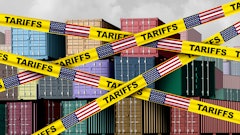
As publicly traded companies await the SEC’s plans for the pending Mandatory Climate Disclosure rule changes, complex manufacturers must look to their own supply chains for hidden risks that could lead to costly legal consequences. The new rules, which would classify greenwashing as SEC fraud, will require all U.S. public companies or those who work with them to disclose their Scope 3 emissions, including the emissions from the entire supply chain. This will significantly affect manufacturers with deep supply chains, who must prepare for a new level of supply chain reporting and disclosures.
Supply chains were never built with sustainability in mind, which means manufacturers with complex supply chains face unique challenges regarding environmental, social and governance (ESG) management. For manufacturing companies, the supply chain contains 90% of environmental impact, presenting a critical risk to their ESG programs. That's why ESG data from suppliers is essential for complex manufacturers to make meaningful improvements in their ESG performance and avoid future regulatory supply chain reporting risks.
When companies engage with their suppliers to understand their ESG impacts, they may not receive full disclosure of material information. For example, a supplier using child labor will likely not self-disclose that information.
Working with suppliers to identify ESG risks in the supply chain will be imperative for manufacturers looking to avoid steep fines and penalties in the future. Luckily for manufacturers, the proposed SEC rule changes include a safe harbor provision for companies that proactively attempt to collect this data from their suppliers. Complex manufacturers should consider the following as they work to uncover, prioritize and monitor risks in their supply chains to meet the new supply chain ESG reporting requirements.
Ignoring supply chain ESG risks is costly
Due to the increased complexity of their supply chains, manufacturers face elevated non-financial issues, including risks associated with bribery, money laundering and criminal activity. Their suppliers' actions can have a significant environmental impact, including greenhouse gas (GHG) emissions.
Many companies rely on self-reported supplier data to meet emerging supply chain sustainability requirements. However, companies are exposing themselves to serious legal, financial and reputational consequences without a program to review this self-reported data.
In many cases, even if the company is not found fully culpable for the environmental or human rights impacts of its supply chain, the costs of inaction are significant:
● Months (or years) of market access loss, often costing millions in lost revenue
● Cost of replacing suppliers, which may require reengineering of the product
● Irreparable brand and reputation damage
● Legal fees
● Time and resources spent completing due diligence to collect missing ESG data and demonstrate compliance
● Inability to meet customer and investor expectations, leading to lost revenue and access to capital
These consequences are not on the horizon – they are happening now, and companies will pay the price. For example, a large North American mining corporation recently faced legal allegations of slavery and torture at its mining operations in Africa. The Canadian Supreme Court ruled that although the violations occurred in the international supply chain, the company was still responsible for the acts. Following the lawsuit and decision, Blackrock Inc. divested millions from the company. Not only did they have to pay legal fees and settlement costs, the loss of investment dollars greatly affected the company’s market position and investor sentiment.
How to identify hidden risks
To discover ESG risks hidden deep in a company’s supply chain, there are two methods to consider:
● Direct monitoring: The practice of contacting suppliers directly to gather and validate ESG performance data with tactics like supplier surveys and data collection templates
● Indirect monitoring: Evaluating supplier performance and detecting risks by monitoring the public domain and identifying potentially concealed information
The goal of both methods is to proactively dig deeper into a company's supply chain's sustainability performance, enabling the detection of hidden risks that may not be within an organization's direct control or are easy to track.
Direct monitoring typically leverages tactics like questionnaires, industry template surveys, or site visits. There are several best practices associated with this method. Manufacturers should rely on industry-standard templates to reduce supplier fatigue and maximize response rates. Crucially, they should also provide education to suppliers. Doing so allows you to engage suppliers as equal partners in sustainability and close performance gaps.
Indirect monitoring can be used to fill in any gaps that are missed by direct monitoring. By monitoring public domain mentions, companies can proactively monitor for situations that might damage their reputation or ESG program. To maximize the effectiveness of this approach, manufacturers should monitor a broad range of sources, including:
● Denied and debarment lists to avoid partnering with a forbidden supply chain entity
● Print, radio and television mentions that publish industry news, including paywalled content from industry journals
● Social media
● Publications from non-governmental organizations (NGOs), watchdog groups and legal offices
● Government publications and notices
Having visibility into the hidden risks isn’t enough. Companies must also establish processes and procedures to act on them. While technology exists to automate many parts of direct and indirect monitoring, both require serious investments of time and expertise in ESG, supply chain sustainability management and product compliance to filter through the overwhelming amounts of data and identify what is relevant and actionable.
Once a manufacturer collects their supply chain ESG risk data, technology combined with expert teams can show them exactly where key supply chain risks exist, which suppliers support a company's ESG strategy, and what risks require the most attention.
As increased regulatory, consumer and investor pressures mount, manufacturers must act quickly to meet emerging ESG supply chain reporting requirements. While the SEC climate disclosures rule changes present a wake-up call for manufacturers not already working to mitigate hidden risks, global regulations that will require a new level of supply chain due diligence and ESG reporting continue to be developed. Manufacturers that proactively prepare for these new requirements through direct and indirect supply chain engagement and monitoring may not only avoid near-term risks, but also position themselves for success in the future as ESG requirements inevitably become more stringent.


















